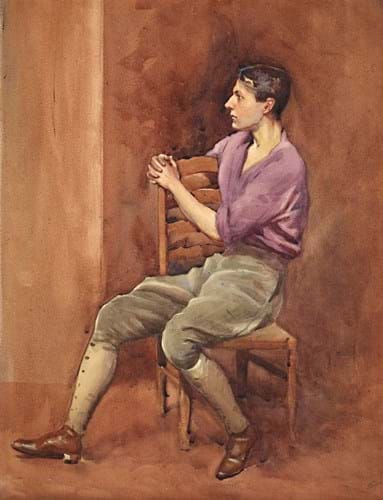It would be difficult to confuse the two, though together they embody the spirit of the show.
One is a study of King George VI by Sir Gerald Festus Kelly (1879-1952) in preparation for the monarch’s coronation portrait.
The other is a watercolour by actor Ernest Thesiger (1879-1961) of a man in loose-fitting V-neck and trousers, which was part of a campaign for comfortable clothes for men (above, top).
The show runs from June 19-24 at The Gallery in Shepherd Market, London.
Like the preceding exhibition of its title held last year, it covers “British life, in all its oddity, flamboyance and peculiarity”. The title is taken from a series of books published in the 1940s, reminding readers why Britain was worth defending (volumes included British Craftsmen, The English at the Seaside, and Life among the English).
The books were propaganda and Sim winkingly follows their thrust, choosing pictures for their historical significance, nostalgic appeal and often their quirkiness.
Reform movement
For example, the Thesiger picture is one of two studies in the show he prepared as examples of Reformed Men’s Dress.
He was a founding member of the Men’s Dress Reform Party in the interwar years, which addressed the impact of clothes on men’s health and hygiene. He also sought to have men’s clothes be more comfortable and colourful.
While some of their causes are today commonplace – shorts in the summer, jumpers and soft shirts – others are less so, such as the kilt as everyday wear.
On the opposite end of the sartorial spectrum is the portrait of King George VI. Kelly was a leading painter in his day and was commissioned to paint the state portraits of George VI and Queen Mary in 1938.
He had not completed them when war broke out and the studies were moved from the artist’s studio – along with the artist. He stayed at the castle for the duration of the war, a popular royal houseguest, though the monarchs stayed in Buckingham Palace.
Three other studies as well as the finished portraits are in the Royal Collection and another study in the Windsor Guildhall.
Though the two are a study in obvious contrasts, the catalogue notes: “It is not too far fetched to suggest that an outspoken advocate of reformed dress would thoroughly have approved of the coronation robes, particularly the airy knee breeches and comfortable buckle shoes.”
The portrait study, completed in oil on canvas laid on board, is available for £15,000.
Other works in the show are available at prices ranging from a few hundred pounds up to around £20,000.
These include works celebrating various British art schools with portraits from the Birmingham Municipal School of Art in 1917 and others by Sir William Orpen and Harold Gilman of the Slade School.
Orpen’s red chalk drawing depicts Emily Scobel, a Slade School model and, briefly, the artist’s fiancée.
She appears in several of his early works including The Mirror (in the Tate collections) where she wears the same hat.
Dated 1900, the picture illustrated the first in-depth article on Orpen and was later owned by Mary ‘Guinea’ Price, a model for Walter Sickert.


















